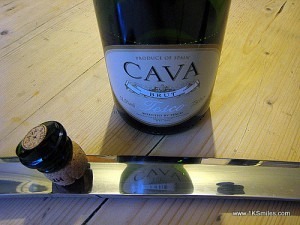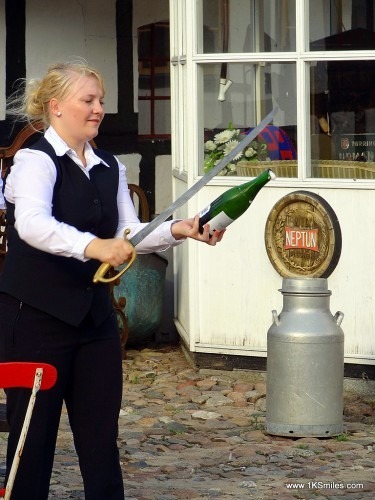Sabrage is a technique for opening a Champagne bottle with a saber, used for ceremonial occasions. Sabrage became popular in France when the army of Napoleon visited many of the aristocratic domains just after the French Revolution and the saber was the weapon of choice of Napoleon’s light cavalry (the Hussars). Napoleon’s European victories gave them plenty of reason to celebrate. The saber is slid along the body of the bottle to break the entire neck away from the bottle, leaving only the base of the bottle open and ready to pour. The force of the blunt side of the blade hitting the lip breaks the glass to separate the collar from the neck of the bottle. Note that one does not use the sharp side of the blade. The cork and collar remain together after separating from the neck.
A champagne sword (sabre à champagne) is an instrument specially made for sabrage. Some of these swords have short blades, around 12 inches long and resemble large knives, although others have longer blades. The side of the blade used should be blunt – a sharpened edge is unnecessary because in sabrage, as in life, it is the impact that is important. If using a sword with a sharp blade you should then use the flat blunt back of the blade. Champagne bottles can be even be opened with a spatula using the same method. Not quite as sexy but can be done none-the-less. The bottle neck is held at an angle of approximately 20-45 degrees and the sword is cast down on it.
The weakest part of the bottle is where the seam meets the bottom of the first lip of the bottle. That’s exactly where you want to hit it with the saber. The impact of the saber on this weak point creates a crack that rapidly propagates through the glass, fueled by the momentum of the saber and the pressure in the bottle. Once the crack has severed the top from the bottle, the pressure inside the bottle and the transferred momentum from the saber will send the top flying, typically for a distance of 15-30 feet. The experienced sommelier can open the bottle with little loss of Champagne. However, they advise to allow a small flow in order to wash away any loose shards of glass that may adhere to the neck. The first glass poured should also be checked for small glass shards.
An article on Fox News explain sabrage like this and is a good recap:
The Champagne has to be cold to reduce the pressure.
You have to completely remove Champagne foil and the cage.
Hold the Champagne bottle at a 45° angle
Slide saber in a smooth motion along the seam of bottle, and pop.
It only works with Champagne.
Sabrage is not one of those things I see very often. Maybe it is a lost art or maybe they just do not do this sort of thing in my social circle. Regardless, whenever I do see it, it always makes me smile.
Get a really nice [easyazon_link asin=”B00AKN6178″ locale=”US” new_window=”default” nofollow=”default” tag=”1ksmiles-20″ add_to_cart=”default” cloaking=”default” localization=”default” popups=”default”]Champagne Saber Classic Wood Handle Sword[/easyazon_link] here on Amazon today!
[easyazon_image add_to_cart=”default” align=”center” asin=”B00AKN6178″ cloaking=”default” height=”166″ localization=”default” locale=”US” nofollow=”default” new_window=”default” src=”http://ecx.images-amazon.com/images/I/31EKb1bzoQL._SL160_.jpg” tag=”1ksmiles-20″ width=”320″]Champagne Saber Classic Wood Handle Sword[/easyazon_image]
[easyazon_cta add_to_cart=”default” align=”center” asin=”B00AKN6178″ cloaking=”default” height=”28″ key=”small-light” localization=”default” locale=”US” nofollow=”default” new_window=”default” tag=”1ksmiles-20″ width=”120″]Champagne Saber Classic Wood Handle Sword[/easyazon_cta]



